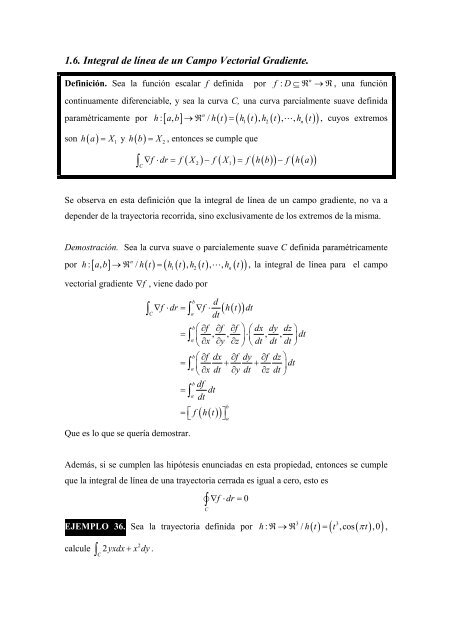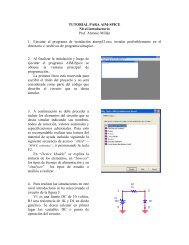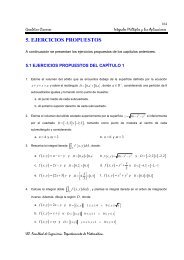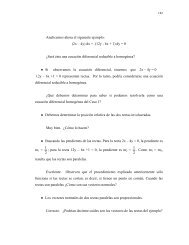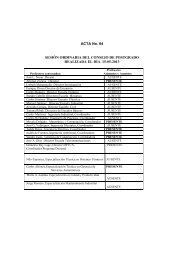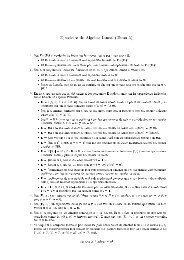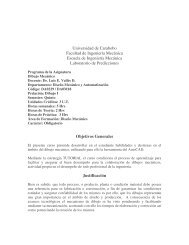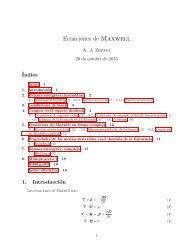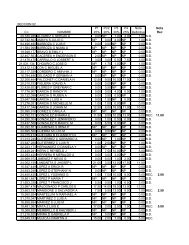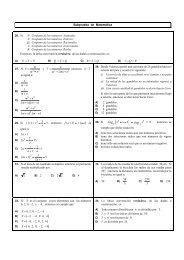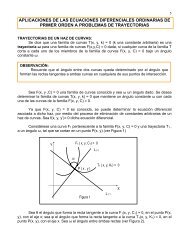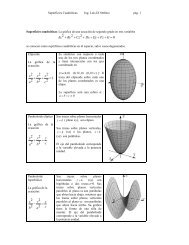Integral de LÃnea de un Campo Vectorial Gradiente
Integral de LÃnea de un Campo Vectorial Gradiente
Integral de LÃnea de un Campo Vectorial Gradiente
Create successful ePaper yourself
Turn your PDF publications into a flip-book with our unique Google optimized e-Paper software.
EJEMPLO 37. Determine si el campo vectorial F( x, y, z) ( 3x 2 y 2, x 3 4y3)no conservativo.= + + , es oSolución. Si el campo F( x, y,z ) es <strong>un</strong> campo vectorial conservativo, implica que es tecampo el gradiente <strong>de</strong> <strong>un</strong>a f<strong>un</strong>ción potencial escalar f ( , , )( , , ) ( , , )xyz, es <strong>de</strong>cir,∇ f xyz = F xyz , <strong>de</strong> manera que se pue<strong>de</strong>n plantear las siguiente ecuaciones∂ f =23x y + 2∂x.1∂ f =3 3x + 4 y∂yEc.2( Ec )( )Al integrar la primera <strong>de</strong> estas ecuaciones con respecto a la variable x, y consi<strong>de</strong>rando lavariable y como <strong>un</strong>a constante, se obtiene la siguiente expresión2 3( , ) = ∫ ( 3 + 2) = + 2 + ( ) ( .3)f xy xy dx xy x h y EcEn don<strong>de</strong>, en el resultado <strong>de</strong> la integral in<strong>de</strong>finida se tiene <strong>un</strong>a f<strong>un</strong>ción arbitraria h( y ),en vez <strong>de</strong> <strong>un</strong>a constante <strong>de</strong> integración arbitraria C. Ahora <strong>de</strong>rivando la expresión <strong>de</strong>f( , )xy con respecto a la variable y, se obtiene la siguiente expresión∂ f = +∂y( )3x h y'Al igualar esta ecuación con (Ec. 2), se tiene que 4 y 3 h'( y)integrara a h'( )y con respecto a y, se obtienen3 4( ) 4∫h y = y dy = y + C= , <strong>de</strong> tal manera que laY al sustituir en (Ec. 3) esta ecuación, se obtiene la f<strong>un</strong>ción potencial f que viene dadapor3 4( , ) = + 2 + + ( .3)f xy xy x y C EcSi se <strong>de</strong>sea <strong>de</strong>terminar <strong>un</strong>a f<strong>un</strong>ción potencial f, cuyo campo vectorial gradiente esta<strong>de</strong>finido por F( xyz , , ) ( F1( xyz , , ), F2( xyz , , ), F3( xyz , , ))ecuaciones= , se plantean las siguientes∂f ∂f ∂f= F1 xyz = F2 xyz = F3xyz∂x ∂y ∂x( , , ) ( , , ) ( , , )
3En don <strong>de</strong> se pue<strong>de</strong> i<strong>de</strong>ntificar por observación que p ( yz , ) = 4y+ 2z, q( x,z) xz2( , ) y sen( x)r x y= , y= , De tal manera que las tres ecuaciones que fueron obtenidas para laf<strong>un</strong>ción f ( , , )xyz son coinci<strong>de</strong>ntes en sus seg<strong>un</strong>dos miembros, y está <strong>de</strong>finida por laexpresión( ) ( )2 3f xyz , , = 4y+ ysenx+ xz + 2zEJEMPLO 39. Sea la trayectoria <strong>de</strong>finida por f : 3 / f ( t) ( t, t 2 , t 3), t [ 0,2]∫ zdx zdy x y dz .calcule + + ( + )CR→R = ∈ ,Solución. Como se pue<strong>de</strong> observar el campo vectorial H( xyz , , ) ( zzx , , y)gradiente <strong>de</strong>l campo escalar h( x, y,z) z( x y)= + es el= + , por lo que el campo H es <strong>un</strong> campoconservativo, la integral <strong>de</strong> línea se pue<strong>de</strong> calcular <strong>de</strong> la siguiente manera( , , ) =∇ H( xyz , , )hxyz∫C∫H⋅ dr = ∇h⋅drC( ( )) h f ( a)= h f b −( ) ⎤2= ⎡⎣t t+t3 20( )= 48Como H es <strong>un</strong> campo vectorial gradiente, la integral no <strong>de</strong>pen<strong>de</strong> <strong>de</strong> la trayectoriarecorrida sino <strong>de</strong> la ubicación <strong>de</strong> los p<strong>un</strong>tos extremos <strong>de</strong> la curva C.⎦EJERCICIOS PROPUESTOS 1.6.1) Determine si el campo vectorial H( xyz , , ) ( y 2 2 xyx , 2 2xy)conservativo.= + + , es o no2) Sea la trayectoria <strong>de</strong>finida por ( ) ( π )−z−zcalcule ∫ e dx + 2ydy + xe dz .C( ) [ ]3 2f : R→R / f t = 4 t,cos t , t , t∈ − 1,1 ,3) Sea la trayectoria <strong>de</strong>finida por f : 3 / f ( t) ( t,1 t,3 t) , t [ 0,3]C( + ) + ( + ) + ( + )∫ z y dx x z dy x y dz .R→R = − − ∈ , calcule
⎡ π ⎤f : R→R / f t = cos t, sent, t , t∈ ⎢0,⎣ 3 ⎥⎦ , calcule34) Sea la trayectoria <strong>de</strong>finida por () ( )C( + 1) + ( + 1) + ( + 1)∫ yz dx xz dy xy dz .5) Evaluar la integral <strong>de</strong> línea2 2∫ 2xyzdx + x zdy + x ydz don<strong>de</strong> C es <strong>un</strong>a curva simpleCorientada positivamente que conecta al p<strong>un</strong>to ( 1,1,1 ) con el p<strong>un</strong>to ( 1, 2, 4 ) .1.6.2. In<strong>de</strong>pen<strong>de</strong>ncia <strong>de</strong> la Trayectoria.Si existen dos curvas C1y C2, suaves o parcialmente suaves, que tienen en común elinicio y fin <strong>de</strong> sus trayectorias, se establece, en general, que∫ F⋅dr≠∫ F⋅dr, pero siC1 C2la f<strong>un</strong>ción F es <strong>un</strong> campo vectorial conservativo, entonces se cumple que∫∇f ⋅ dr = ∫ ∇f ⋅dr, siempre que ∇fsea <strong>un</strong> campo continuo en el dominio D al cualC1 C2pertenece la curva C. Esto significa que el valor <strong>de</strong> la integral <strong>de</strong> línea <strong>de</strong> <strong>un</strong> campovectorial conservativo <strong>de</strong>pen<strong>de</strong> solamente <strong>de</strong>l p<strong>un</strong>to inicial y <strong>de</strong>l p<strong>un</strong>to final <strong>de</strong> <strong>un</strong>acurva, y no <strong>de</strong> la trayectoria recorrida por ésta.Definición. Si F es <strong>un</strong> campo vectorial continuo en <strong>un</strong> dominio D, don<strong>de</strong> la curva Cesta incluida, se dice que la integral <strong>de</strong> línea∫ F⋅dr es in<strong>de</strong>pendiente <strong>de</strong> la trayectoria,Csi se cumple que∫ F⋅ dr = ∫ F⋅dr, para cualesquiera dos trayectorias C 1y C 1C1 C2contenidas en D que tengan los mismos p<strong>un</strong>tos inicial y final.


